Mega Archive: Part XIX: From Atomic Runner to Super Smash TV
By Mento 0 Comments
It's another action-packed entry of the Mega Archive as we enter July and the second half of 1992 for the Sega Mega Drive/Genesis. The summer of '92 continues to be dominated by western debuts, but a remarkable trend emerging here (if the release data is correct, and I've taken every step to be as accurate as possible) is that many Japanese studios are launching their games States-side first, possibly because the market is so much more lucrative. As a refresher, the Mega Drive in its native land was losing badly to the Super Famicom (SNES)*, but the savvy marketing of Sega of America (and its European equivalent) and third-party support from the likes of EA meant the Genesis was still the market leader there. I've no head for commerce, but it seems like distributing to the larger and more receptive audience available in the States first makes a lot more business sense. Hey, if it keeps this Mega Drive retrospective out of endless shogi and pachinko games, I'm all for this western-weighted direction.
As for the composition of this entry's batch of fifteen, it's an eclectic bunch. We have our first ever Genesis fishing game (yaaaay), the return of the ostentatiously-named shoot 'em ups, the usual licensed dreck, a genuine collector's item, anime dodgeball, and - to fit with the theme of the month - a gory horror favorite. We also have an RTS game and a Westwood Studios game this entry, but they're not the same item. Sorry C&C fans.
(* This Wikipedia page gives you an idea of the amount of contrast between the one-sided Mega Drive vs. Super Famicom battle in Japan and the more evenly matched war waging in the US between the Genesis and SNES. In Japan, the Mega Drive sold only 3.5 million units to the SFC's 17 million; in the US, both systems were around 22-23 million, with the SNES squeaking ahead due to a longer lifespan.)
I'm going to have to make a shorter version of this list soon, damn:
- Part I: 001-020 can be found here.
- Part II: 021-035 can be found here.
- Part III: 036-050 can be found here.
- Part IV: 051-065 can be found here.
- Part V: 066-080 can be found here.
- Part VI: 081-098 can be found here.
- Part VII: 099-115 can be found here.
- Part VIII: 116-130 can be found here.
- Part IX: 131-145 can be found here.
- Part X: 146-160 can be found here.
- Part XI: 161-175 can be found here.
- Part XII: 176-190 can be found here.
- Part XIII: 191-205 can be found here.
- Part XIV: 206-220 can be found here.
- Part XV: 221-240 can be found here.
- Part XVI: 241-255 can be found here.
- Part XVII: 256-270 can be found here.
- Part XVIII: 271-285 can be found here.
Part XIX: 286-300 (July '92 - August '92)
286: Atomic Runner / Chelnov
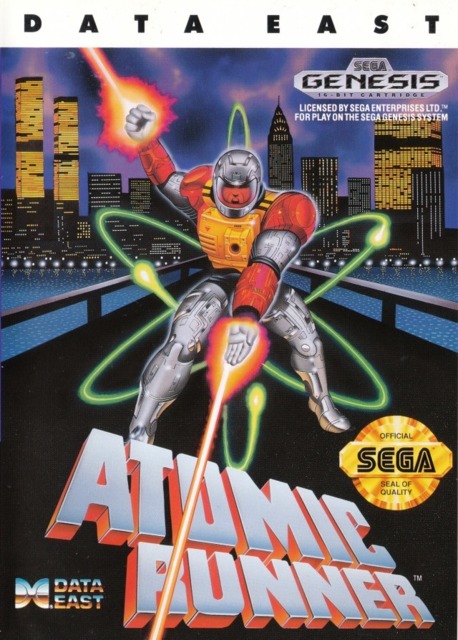
- Developer: Data East
- Publisher: Data East
- JP Release: 1992-10-16 (as Chelnov)
- NA Release: July 1992 (as Atomic Runner)
- EU Release: 1992 (as Atomic Runner)
- Franchise: N/A
- Genre: Platformer / Shooter
- Theme: Sci-fi
- Premise: Not many action heroes are inspired by the Chernobyl disaster, but Atomic Runner Chelnov is no ordinary action hero. (They later retconned it, of course. Thousands of deaths by radiation-induced cancer can suck the fun out of anything.)
- Availability: Nothing more recent than a Japan-only Wii Virtual Console release. Paon owns the rights to Chelnov and Karnov after buying a lot of Data East's catalog, but they've been quiet for a while. Chelnov the character, however? He can be seen in the crowd in Windjammers 2, so he's doing just fine chillin' and watching some frisbee.
- Preservation: Atomic Runner always felt like Data East's take on a Strider or Contra - it moves at a clip and bombards the player with enemies and visual stimuli, which is partly why it's such a challenging game. Much like sharks, I'm not sure Chelnov is allowed to slow down. Atomic Runner is also one of those games where people are much more familiar with the home version than the arcade version. That's a testament to how well it was ported over: the most significant changes are mostly superficial, like the new less-insensitive story about a pre-human civilization named the "Deathtarians" (which sounds like a diet where you only eat corpses) and some reworked backgrounds to befit the new lore. Chelnov had an interesting history post-Genesis: for its Sharp X68000 computer port, it came with a peripheral that allowed you to play it with a Genesis controller (this adapter was also compatible with a few other X68k arcade ports), and it was also going to see a Saturn port before that got cancelled close to completion (though a prototype has since emerged).
287: European Club Soccer / World Trophy Soccer / J. League Champion Soccer
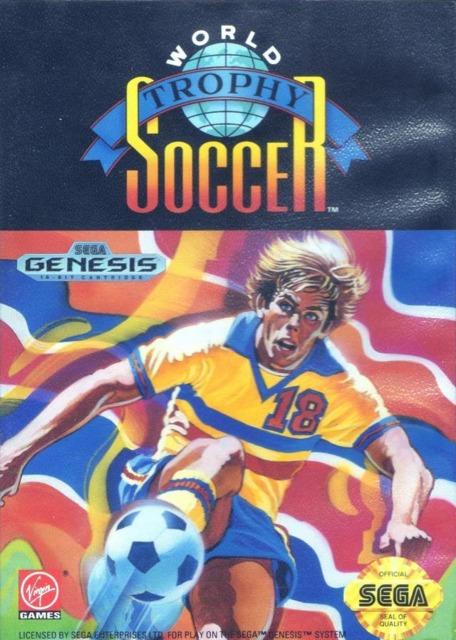
- Developer: Krisalis Software
- Publisher: Virgin Interactive (EU/NA) / Game Arts (JP)
- JP Release: 1993-02-26 (as J. League Champion Soccer)
- NA Release: September 1992 (as World Club Soccer)
- EU Release: July 1992 (as European Club Soccer)
- Franchise: N/A
- Genre: Soccer
- Theme: Soccer
- Premise: Soccer is soccer, regardless of which part of the world it's being played in. They sure punted this one around though.
- Availability: Just play FIFA 21 instead, unless you're really dead set on playing as Yugoslavia.
- Preservation: A UK-developed port, or reworking, of a computer soccer sim based on Manchester United FC, European Club Soccer (which came first) had an ambitious 170 teams taken from various European leagues. The American version uses national teams instead, as America only pays attention to soccer (if ever) during the World Cup. Japan's version not only uses their own J. League, but actually bothered to acquire the licenses to use those team and player names; in a sense, theirs is the most legit version, though it only has the ten teams instead of 170. Also, why are Game Arts putting this jank soccer game out in Japan? You just made Lunar! Rest on your laurels, why don't you.
288: King Salmon: The Big Catch
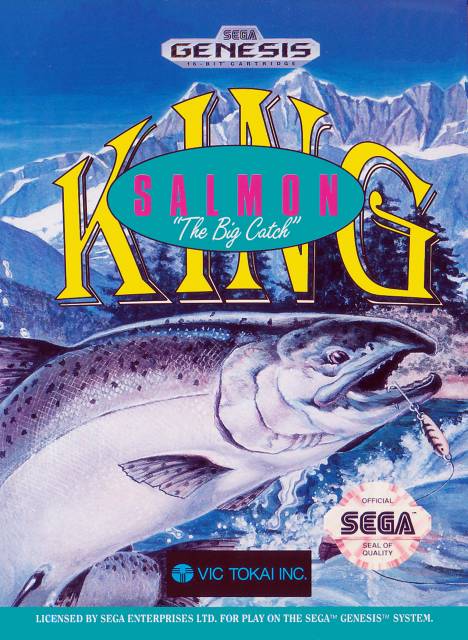
- Developer: HOT-B
- Publisher: HOT-B (JP) / Vic Tokai (NA)
- JP Release: 1992-09-26
- NA Release: July 1992
- EU Release: N/A
- Franchise: N/A
- Genre: Fishing
- Theme: Aquatic
- Premise: Hook up the world's largest salmon in this, the first fishing simulator for the Mega Drive. (The "Big Catch" here is that fishing games are tedious.)
- Availability: No ports or rereleases have made their way upstream as of yet.
- Preservation: HOT-B are back, doing what they do best. They first cast their lines on the NES with the Black Bass series, and presumably they figured they should be switching fish if they were switching console manufacturers. Hard to say if the NA release date is accurate here: my usual source took that date from the April '92 issue of GamePro, but a 1993 credit to Sage's Creation (HOT-B's American publishing subsidiary) on the title screen suggests otherwise. GameFAQs has a March '93 date but I've no idea where they sourced it from, so... shrug? Feel like I've been fishing harder for some definitive release info than I have for the salmon. Final note: I like the idea that someone decided they should use a salmon-colored font for the word "salmon" on the box art, which was then nixed at the last moment because it was the early '90s and everything had to be hot pink on teal.
289: Splatterhouse 2
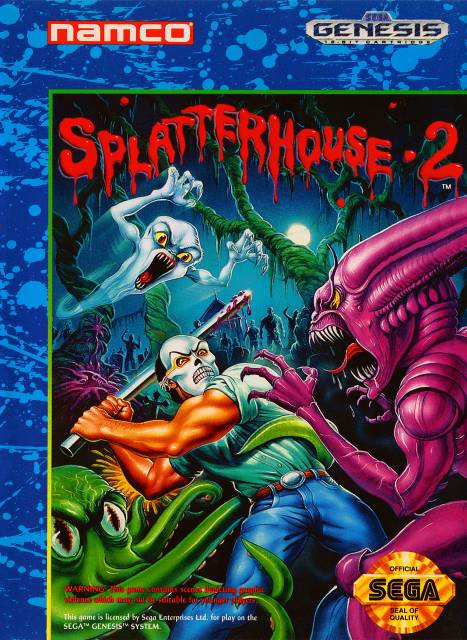
- Developer: Now Production
- Publisher: Namco (JP/NA) / Sega (EU)
- JP Release: 1992-08-04
- NA Release: July 1992
- EU Release: 1992-10-08
- Franchise: Splatterhouse
- Genre: Brawler
- Theme: Horror
- Premise: The West Mansion is a smoking ruin, but Rick still left some things un-smashed with his trusty two-by-four.
- Availability: There's the Wii Virtual Console rerelease from 2008, and Splatterhouse fans might also want to check out the 2010 360/PS3 series reboot if they somehow haven't already.
- Preservation: We talk a lot about console exclusivity in this day and age, rather than developer exclusivity which was more the case in the 16-bit era, and one of earliest examples of the former was Namco deciding to make Splatterhouse sequels solely for the Mega Drive, given Sega was a little more amenable to its blood-and-guts B-movie charms than the family-focused Nintendo. Both Splatterhouse 2 and Splatterhouse 3 would remain on Sega platforms until their inclusions on the Wii Virtual Console many years later. Splatterhouse 2 isn't all that complicated a gaming experience, and still maintains an arcade sensibility despite only being on home console. Probably best they didn't complicate the simple joys of hitting a ghoul in the face with a club until it explodes into viscera.
290: Taz-Mania
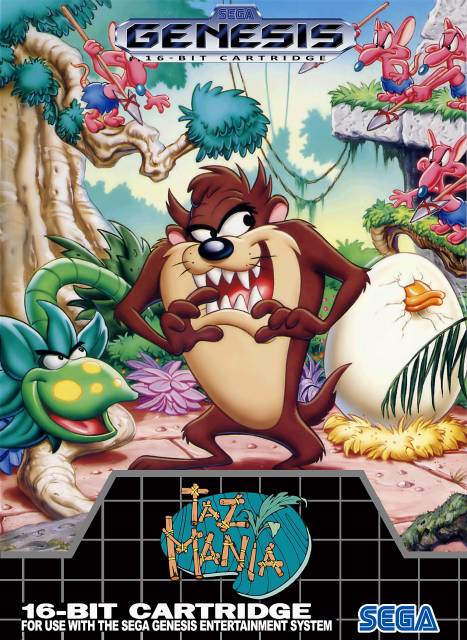
- Developer: Recreational Brainware
- Publisher: Sega
- JP Release: 1992-12-25
- NA Release: July 1992
- EU Release: July 1992
- Franchise: Looney Tunes
- Genre: Platformer
- Theme: Cartoon Mayhem
- Premise: Upon hearing a tale about Tasmania's enormous prehistoric seabirds, Taz decides to seek out their eggs to make a giant omelet.
- Availability: Licensed platformer, so I doubt it's coming back unless Warner Bros. decides to "The Disney Afternoon Collection" its wide range of questionable Looney Tunes games.
- Preservation: Despite the Taz character's enduring popularity and the familiar format of smart-ass meta humor delivered through disconnected skits, you don't hear about Taz-Mania as much as you might a Tiny Toons or Animaniacs. I wonder if the Antipodean humor made it a little alienating to American audiences? Also why was Taz's father based on Bing Crosby? What age group was that cartoon aiming for, exactly? Anyway, I'm talking about the show because I've very little to say about this generic mascot platformer beyond that it probably helped pave the way for Crash Bandicoot - pretty much the same character only with enough dignity to cover up his shame with a pair of denim cargo shorts - and that the SNES Taz-Mania game is completely different (it's a racing game? Sorta?). Not for nothing, but "Recreational Brainware" is a fantastic developer name and it's a pity they never put anything else out... well, except the company did have a hand in a certain upcoming game starring an undead anti-hero. It won't be Forever, Man, before we reach him.
291: Wheel of Fortune
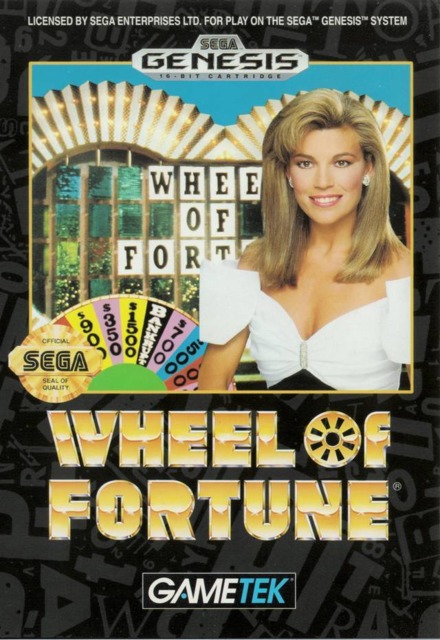
- Developer: Imagitec Design
- Publisher: GameTek
- JP Release: N/A
- NA Release: July 1992
- EU Release: N/A
- Franchise: Wheel of Fortune
- Genre: Quiz/Trivia
- Theme: Game Show
- Premise: America's favorite game show, or at least its favorite game show where you don't need to know anything, is coming to Genesis! And Game Gear, and SNES, and NES, and Game Boy, and...
- Availability: It seems like every decade someone gets their hands on the Wheel of Fortune license and puts something out. I think Ubisoft had it last?
- Preservation: I mean, this is exactly what you think it is. A home version of a TV quiz show, which I've no doubt was one of the prizes of the actual quiz show for a while. One thing I learned about this game, despite having dealt with it once already while working on SNES pages, is that it was developed in the UK despite being a North American exclusive release. That means there were plenty of British English spellings to baffle those poor American kids who were already confused about receiving this as a birthday gift from relatives they had previously thought loved them, though I'm sure all those extra "U"s everywhere wasn't a concern in a game like this where words and spelling play such minor roles. Rest assured, we'll be seeing many more TV show adaptations from GameTek yet (and, uh, Zool apparently).
292: Honoo no Toukyuuji: Dodge Danpei
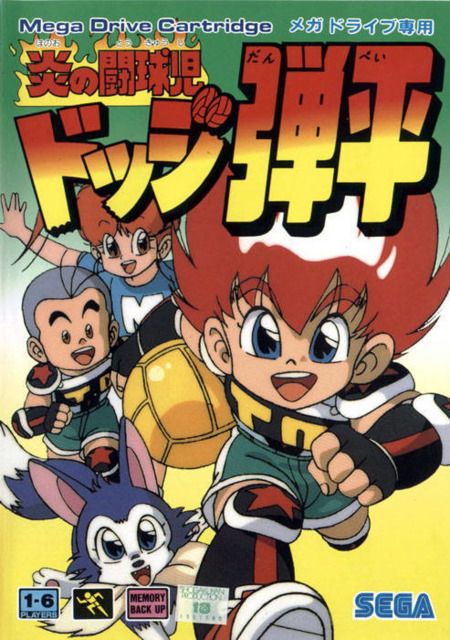
- Developer: Sega
- Publisher: Sega
- JP Release: 1992-07-10
- NA Release: N/A
- EU Release: N/A
- Franchise: Honoo no Toukyuuji: Dodge Danpei
- Genre: Dodgeball
- Theme: Anime
- Premise: Are you ready for some high-octane anime dodgeball? The correct answer is no. Nobody is ready for high-octane anime dodgeball.
- Availability: Nothin' doin'. Another licensed game, based on a property that is a complete unknown outside of Japan (and, I'm guessing, inside of Japan beyond a certain period of the 1990s).
- Preservation: Honoo no Whatsit is going to be a major pain in my ass in the near future, since it was one of those hot manga/anime licenses that everyone had to have on their console of choice. The license thus got spread around to many different developers (Sega, Sunsoft, Hudson, AIM, and SIMS), producing six marginally different versions of the same game that probably all deserve to have separate pages. It doesn't help that they all play the same too: though there are graphical differences they all look like Technos's Super Dodgeball, which I guess was the only other dodgeball game in town.
293: Advanced Busterhawk Gley Lancer
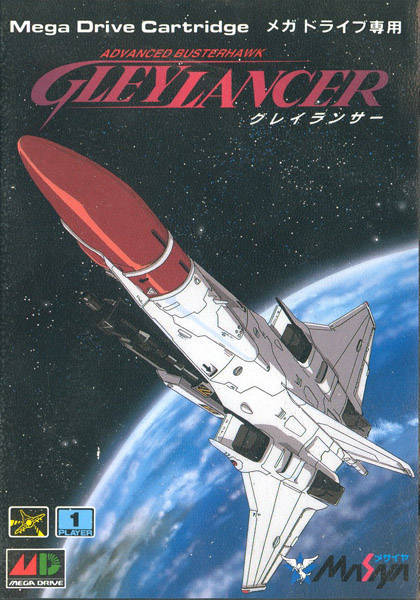
- Developer: Masaya
- Publisher: Masaya
- JP Release: 1992-07-17
- NA Release: N/A
- EU Release: N/A
- Franchise: N/A
- Genre: Shoot 'em up (Horizontal)
- Theme: Space Anime
- Premise: 16-year-old ace cadet Lucia is determined to rescue her father from the aliens that teleported his frigate to destinations unknown, even if it means stealing Earth's most advanced starfighter to do so. Way to guard the ship from a single teenage girl, idiots.
- Availability: Your best bet is either the Wii Virtual Console, which was the game's only international release, or a recent (2019!) reissue of the original Japanese cart from Columbus Circle.
- Preservation: Gley Lancer was one of those high-value Mega Drive carts, between its relative rarity (it's Japan-only) and, I suppose, Masaya's penchant for fancy anime showmanship. Like Zero Wing, there's a whole introductory sequence with dialogue and dramatic editing to get you into the swing of things, and then it's business as usual with a menu of different option systems and some attractive but generic horizontal shoot 'em up action. The Wii Virtual Console once was again the hero of the retro preservation scene, distributing Grey Lancer for the first time to the unwashed masses of the western continents in 2008 to the chagrin of whichever chumps paid ¥10,000 to import it.
294: Ayrton Senna's Super Monaco GP II
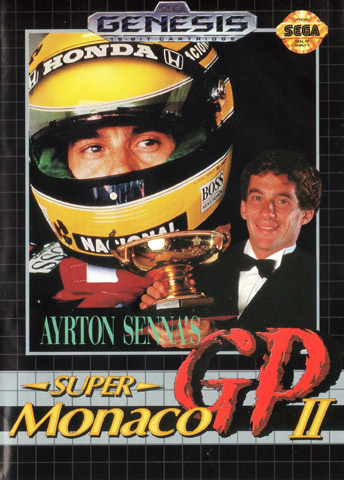
- Developer: Sega
- Publisher: Sega
- JP Release: 1992-07-17
- NA Release: September 1992
- EU Release: August 1992
- Franchise: Monaco GP
- Genre: Racing
- Theme: Formula 1 Motorsports
- Premise: Follow the Brazilian F1 superstar around some of his favorite tracks in this newly endorsed outing for Sega's arcade Monaco GP series.
- Availability: While a popular first-party game at the time, being endorsed by Ayrton Senna complicates matters. Not like you can just call him up and ask for likeness rights these days...
- Preservation: I'm not going to lie, this one's not really worth anyone's time today unless they're already dedicated to Formula 1 or have any affinity for the unfortunate Sr. Senna. It still has some of Sega's arcade-y racing game sensibility, as evinced by an automatic transmission setting (aren't those banned in F1 now?), but there's plenty of serious simulation elements in this series too, more so once they got a professional driver involved to supervise. Still, if you were a documentarian charting the evolution of Formula 1 video game adaptations (i.e. Danny O'Dwyer, the only person I could imagine doing this), Super Monaco GP II seems like an important inclusion.
295: Dyna Brothers
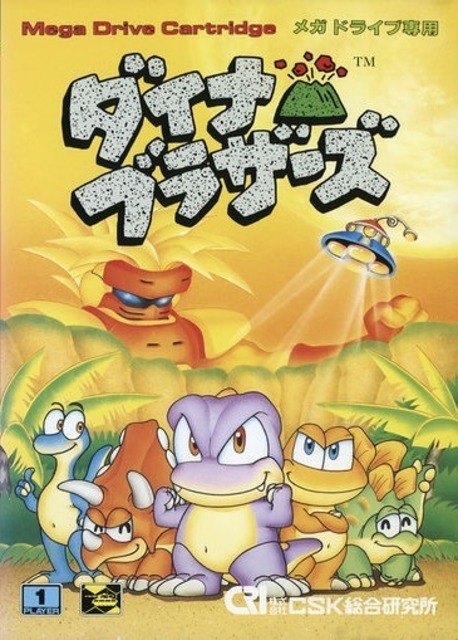
- Developer: CRI
- Publisher: CRI
- JP Release: 1992-07-24
- NA Release: N/A
- EU Release: N/A
- Franchise: N/A
- Genre: Real-Time Strategy
- Theme: Prehistoric
- Premise: Help the dinosaurs stave off their inevitable annihilation for a couple extra million years by chomping on some alien invaders.
- Availability: Besides the original MD cart, there was also a Wii Virtual Console release in 2007. Both are Japan-only though.
- Preservation: We've talked about CRI before - they were the brainchild of CSK (the IT parent company of Sega between 1984 and 2004) and used their nerdy tech knowhow to help usher in Sega's CD-based future with the Mega CD and subsequently the Saturn and Dreamcast, and post the Sega hardware age they became ubiquitous middleware developers. They would on occasion put out games too, including this RTS game where dinosaurs fight aliens. There are five dinosaurs that the player generates by spending resources like they might troops in Warcraft, each of which serves a distinct role from gathering energy to tanking enemies to quickly eating alien eggs so they can't spawn reinforcements, and the player can also assist their side Populous-style with beneficial weather effects. It seems a bit rudimentary and goofy compared to RTS games today, but it's worth remembering that mid-1992 is still the prehistoric (as it were) era for the genre, since the big games that would go on to define it - Dune II, Command & Conquer, Warcraft - had yet to be released.
296: Thunder Force IV / Lightening Force: Quest for the Darkstar
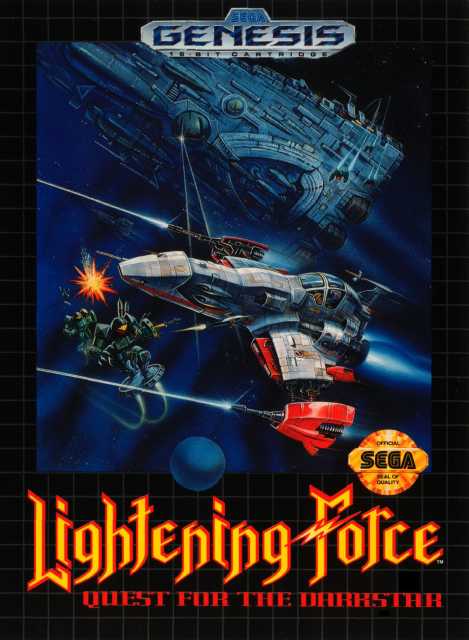
- Developer: Technosoft
- Publisher: Technosoft (JP) / Sega (NA/EU)
- JP Release: 1992-07-24
- NA Release: 1992
- EU Release: 1992
- Franchise: Thunder Force
- Genre: Shoot 'em up (Horizontal)
- Theme: Sci-fi
- Premise: Thunder Force III saw the destruction of the genocidal ORN Empire, but suddenly they're back again. Like they always say, there's one ORN every minute.
- Availability: Thunder Force fans are in luck - #4 was recently added to the Sega Ages range for Switch.
- Preservation: Technosoft was one of the Mega Drive's earliest third-party supporters and their flagship Thunder Force franchise has always been something of a technical showcase, able to demonstrate the tech of the system at its peak as effectively as Sega themselves. Despite being saddled with a bizarrely terrible name for its US localization and only its US localization (is that a typo? Or was the ship baked with self-raising flour?), it's one of the more attractive games to be released on the Mega Drive especially by what was available in 1992. I've always been terrible at shoot 'em ups and am largely ambivalent whenever one shows up on this list, but between their speed and the sheer number of on-screen sprites involved they're good litmus tests for how well a developer understands the console they're developing for.
297: Twinkle Tale
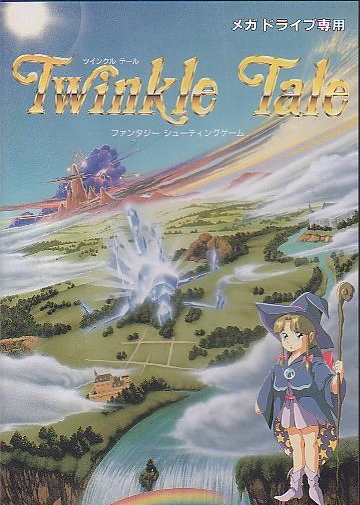
- Developer: ZAP
- Publisher: Wonder Amusement Studio
- JP Release: 1992-07-24
- NA Release: N/A
- EU Release: N/A
- Franchise: N/A
- Genre: Top-Down Shooter
- Theme: Baby Witches, Possibly Cursing the Moon
- Premise: Apprentice witch Saria must rescue the sages from evil forces with all the destructive elemental forces an anime teenager can conjure.
- Availability: No rereleases, original Japanese cart only. This one's pretty rare too.
- Preservation: It feels like every 16-bit console had its own Japan-only fan-coveted anime magical girl cute 'em up games. The TurboGrafx-16 had Magical Chase, the SNES had Cotton 100% and Magical Pop'n, and the Mega Drive got theirs with 1992's Twinkle Tale. One major departure from its peers is that Twinkle Tale has a Commando/Ikari Warriors top-down perspective where your character is on foot, presumably having not yet passed broomstick training. I'm a little more partial to games of this type, especially as a break from all the sci-fi shoot 'em ups, and it's a fine looking game if a bit grainy. The bosses are the usual highlights here, each one filling the screen with its bulk and endless amounts of projectiles, though a generous power-up and weapon-switching system alleviates to some degree the frustrating downgrading that comes after getting hit. It didn't quite garner the cult following of its aforementioned magical girl compatriots, never seeing a rerelease or remaster of any kind, but it did receive an English fan translation back in 2007 at least.
298: Dungeons & Dragons: Warriors of the Eternal Sun
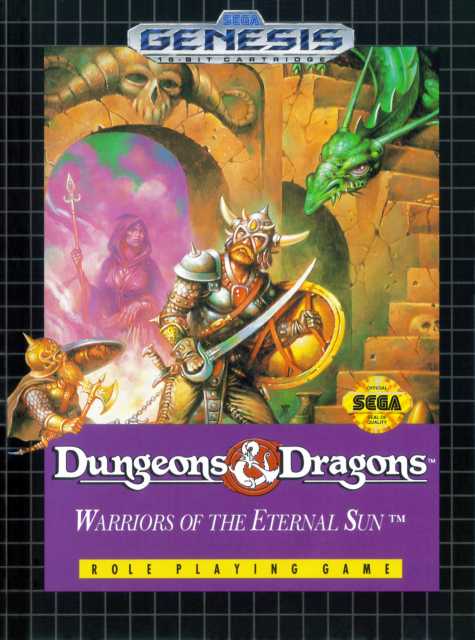
- Developer: Westwood Studios
- Publisher: Sega
- JP Release: N/A
- NA Release: August 1992
- EU Release: August 1992
- Franchise: Dungeons & Dragons
- Genre: RPG
- Theme: Shooting Fireballs at Dinosaurs
- Premise: A kingdom on the verge of goblin conquest is suddenly thrown into a strange new world with a red sun. Who loses a war with goblins? You'll find out once you roll up a party and get wiped by the first normal-sized snake you meet.
- Availability: Probably too many licensing issues around this one to see a rerelease, since both Wizards of the Coast and Sega would need to get involved. It's up to Westwood IP owners EA if they want to work that all out.
- Preservation: During the early '90s, we saw an unusual trend by D&D license holders to explore the more obtuse settings and campaigns of the famous table-top game, beyond the more well-established worlds of the Forgotten Realms and Dragonlance. Between 1992 and 1994 we had the first games based on Ravenloft (vampires), Spelljammer (space), Al-Qadim (genies), Dark Sun (shirtless gladiators), and Mystara ("classic flavor" D&D). The last of those is where we find Warriors of Eternal Sun, which for an extra layer of esoterica is set in Mystara's "Hollow World": an inverted land inside the middle of Mystara's planet, populated by dinosaurs and beastmen races. Beyond that, it plays a little like a fusion of SSI's Gold Box and Origin's Ultima, in particular adopting Ultima IV-VII's distinctive oblique top-down perspective everywhere except its first-person dungeons. Despite sharing a lot of mechanical similarities with its CRPG brethren, Warriors of the Eternal Sun was exclusive to the Sega Genesis. (Couple of extra notes: Westwood also made another console-only D&D Mystara game the same year with Order of the Griffon for TurboGrafx-16. Mystara is also the campaign setting Capcom used for their D&D arcade brawlers, but I forget if either of those ever went to the Hollow World.)
299: Rampart
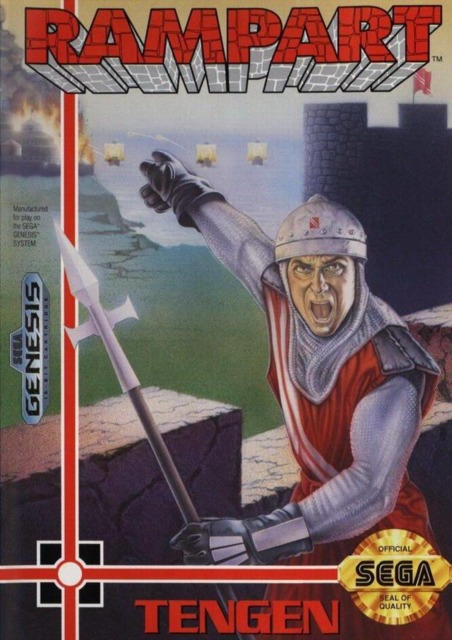
- Developer: Tengen
- Publisher: Tengen
- JP Release: 1992-12-11
- NA Release: August 1992
- EU Release: N/A
- Franchise: N/A
- Genre: Strategy / Puzzle
- Theme: Castles
- Premise: Defend your lands by building walls and forts for all the enemy ships to knock down with their cannons. You can knock them down with cannons too though, so it's all fair and shit.
- Availability: Rampart been rereleased many times, including in the Midway Arcade Treasures compilation for PS2/Xbox and Midway Arcade Origins for PS3/360. I'm sure you can find it on iOS these days too, probably under a legally distinct name.
- Preservation: Tengen's still at it, porting over every Atari arcade game they can dig out of the dumpsters outside of the Dave & Buster's (I kid; at the time Rampart was still fairly new). I always liked Rampart, but I think that's because I always liked Tetris and shooting cannons at boats, so maybe the ingenuity of its hybrid format was lost on me at the time. Rampart could be considered the ancestor to the entire tower defense genre, especially in the way it separates the "building" and "defense" modes into two ever-alternating halves. The Genesis port is fine enough, but this is a game served better by the original arcade cabinet's trackball or a mouse given the precision required by both the building and shooting modes. Nothing worse than building 90% of a fort's circumference only to leave a gap because you hit confirm in the wrong place.
300: Super Smash TV
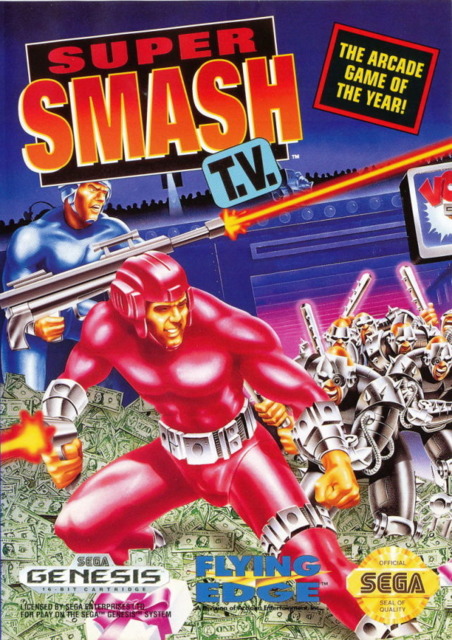
- Developer: Probe Entertainment
- Publisher: Flying Edge
- JP Release: N/A
- NA Release: August 1992
- EU Release: December 1992
- Franchise: N/A
- Genre: Top-Down Shooter
- Theme: Big Money, Big Prizes
- Premise: If you want to risk life and limb for a chance to win a hundred VCRs, Smash TV is the bloodsport game show of the future for you!
- Availability: I would've said the XBLA version since it has online multiplayer, but that got delisted a decade ago. Shows how tuned in I am.
- Preservation: Let's be real, while the home versions of Smash TV (many of which were called Super Smash TV, despite having no obvious enhancements) were fun in spurts you lose a lot trying to port a dual-stick shooter to consoles that don't even have the one stick on their controllers. I realize this ain't dancing with the one what brung ya, but I think the SNES version fares slightly better as a compromise because its diamond-formation face-buttons function as a second D-pad for multidirectional shooting. In comparison, the Genesis controls are just... weird. Instead of trying to assign the three buttons to directions (hope you don't need to shoot down!), they'll either shoot in the direction you're moving, or the opposite direction, or toggles a locked firing mode (which is a configuration the Mega Drive sometimes used with shoot 'em ups, like Gley Lancer above). If you wanted more shoot buttons, you could choose to play the "1 player, 2 controllers" mode which I'm not sure will make your life any easier. I got burned a number of times as a kid with a much-anticipated arcade or computer console conversion that didn't quite work out (in retrospect, expectations were perhaps absurdly high for a decent SNES Theme Park), so I feel for any kid at Christmas forced to adjust to the console limitations this port exposes.

0 Comments